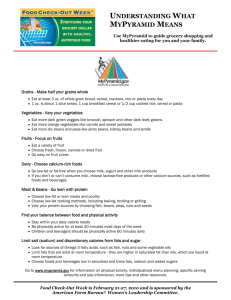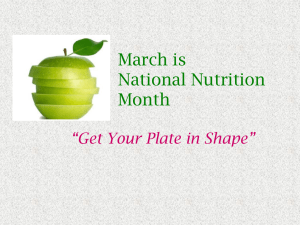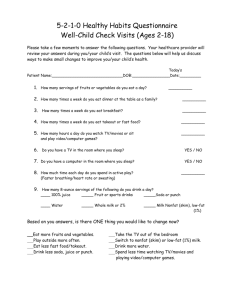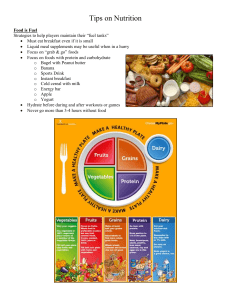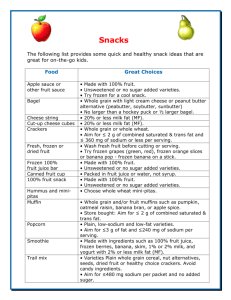Healthier Concession Stand Choices
advertisement
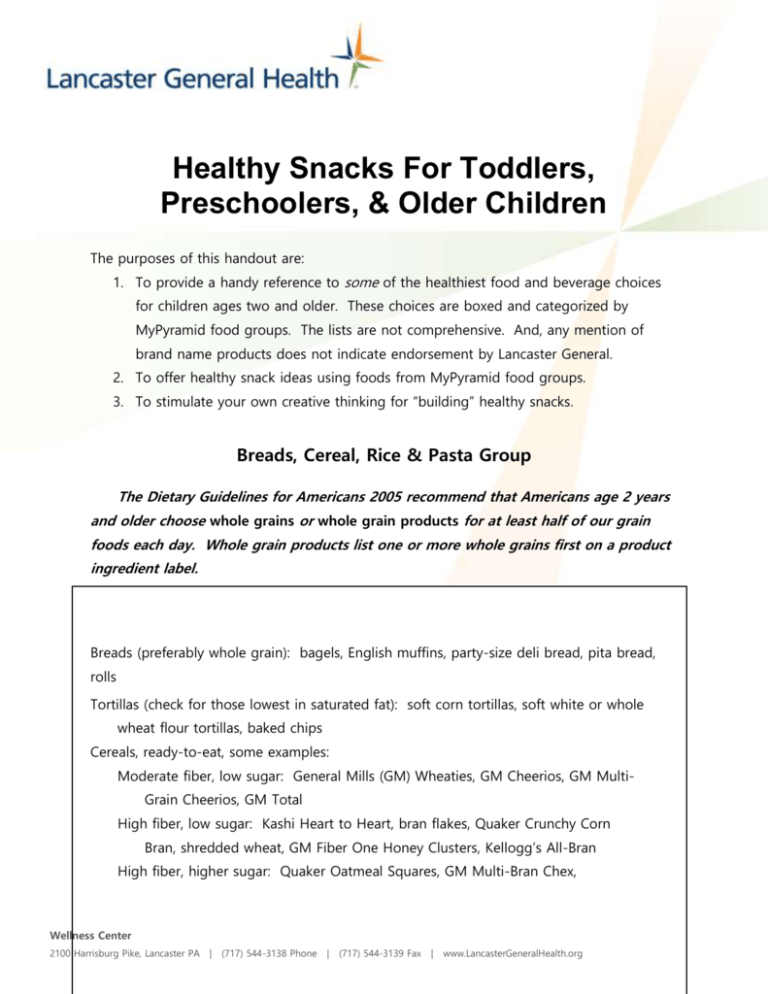
Healthy Snacks For Toddlers, Preschoolers, & Older Children The purposes of this handout are: 1. To provide a handy reference to some of the healthiest food and beverage choices for children ages two and older. These choices are boxed and categorized by MyPyramid food groups. The lists are not comprehensive. And, any mention of brand name products does not indicate endorsement by Lancaster General. 2. To offer healthy snack ideas using foods from MyPyramid food groups. 3. To stimulate your own creative thinking for “building” healthy snacks. Breads, Cereal, Rice & Pasta Group The Dietary Guidelines for Americans 2005 recommend that Americans age 2 years and older choose whole grains or whole grain products for at least half of our grain foods each day. Whole grain products list one or more whole grains first on a product ingredient label. Breads (preferably whole grain): bagels, English muffins, party-size deli bread, pita bread, rolls Tortillas (check for those lowest in saturated fat): soft corn tortillas, soft white or whole wheat flour tortillas, baked chips Cereals, ready-to-eat, some examples: Moderate fiber, low sugar: General Mills (GM) Wheaties, GM Cheerios, GM MultiGrain Cheerios, GM Total High fiber, low sugar: Kashi Heart to Heart, bran flakes, Quaker Crunchy Corn Bran, shredded wheat, GM Fiber One Honey Clusters, Kellogg’s All-Bran High fiber, higher sugar: Quaker Oatmeal Squares, GM Multi-Bran Chex, Wellness Center 2100 Harrisburg Pike, Lancaster PA | (717) 544-3138 Phone | (717) 544-3139 Fax | www.LancasterGeneralHealth.org frosted shredded wheat, Kashi Go LEAN Crunch Cereals, cooked: oatmeal, wheatena, baby cereal (iron-fortified) Grains: rice (brown preferred), pasta (whole grain preferred), quinoa, kamut, barley, buckwheat, millet, etc. Pancakes: whole grain or multigrain pancake mixes like Arrowhead Mills and Hodgson Mill Waffles: types made with whole grains like GoLEAN frozen waffles Quick breads, cornbread, and muffins: best are those that contain at least some whole grains, fruits or vegetables, low-fat or fat-free dairy (milk, buttermilk, yogurt) and highly unsaturated fats or oil (not butter or hydrogenated shortening) Cereal fruit bars/ granola bars: choose low-fat ones with at least 1 g fiber per serving Crackers: whole grain, reduced/low-fat types, like Nabisco Reduced-Fat Triscuits, Ry Krisp, whole wheat matzos, Wasa Light Rye, Finn Crisp, Ryvita, whole grain rice or popcorn cakes; other low-fat types like saltines, mini oyster crackers, low-fat graham crackers, animal crackers Pretzels: oat bran, whole wheat, multigrain types; frozen soft pretzels (limit salt) Snack ideas for breads, cereal, rice & pasta group Breads: 1. Serve plain or toasted. 2. Use rolling pin to flatten bread, and then roll up with a healthy filling. 3. Cut bread or bread sandwiches into shapes. 4. Cut mini pita pockets in half; add filling to pockets. 5. Split pita at seams, brush lightly with tub margarine or oil, season if desired with saltfree herb-spice blend or cinnamon-sugar. Toast in a preheated 350 oven for ~15 minutes or under the broiler until crispy. Or, bake melba-thin bread or thin slices of bagels. 6. Topping & filling ideas: soft margarine, smooth peanut butter or other nut butters (like soynut butter, almond butter), sliced or grated apple, applesauce, apple butter, sliced or mashed bananas, raisins, mashed or refried beans, reduced fat cheese, egg salad, shredded leftover chicken or turkey, lean deli meats or low-fat meat salads, shredded vegetables (lettuce, carrots, cabbage, zucchini, etc) with low-fat dressing, a combination of items. 7. Make mini sandwiches using party-size bread. Serve cold or grilled in a skillet. Soft tortillas: 1. Roll up tortillas with healthy fillings: see ideas under #6 above 2. Spread tortilla with pizza sauce, tomato sauce, or sun-dried tomato pesto; add leftover cooked chopped vegetables; and shredded reduced-fat cheese. Microwave ~ 10-20 seconds or broil until cheese melts; allow to cool slightly before serving. Cut tortillas into triangles, or roll up and cut crosswise into slices. 3. Spritz tortillas with cooking spray or brush lightly with vegetable oil; add herbs/spices (corn tortillas with Mexican blend; flour tortillas with Italian blend, Mexican blend, cinnamon-sugar, other) if desired. Cut tortillas into triangles, strips, or cookie-cutter shapes (metal cutters work best). Place on baking sheet and bake in 375 F oven for 612 minutes or until crispy. Cool on wire racks. Cereals: 1. Mix high-fiber and low-fiber cereals together. Make “marshmallow treats” with whole wheat flake cereal or a mixture of cereals instead of with the low-fiber crisp rice cereal. 2. Cook hot cereals or cold cereals (like shredded wheat, nugget cereal, etc.) with fat-free or low-fat milk or soy milk. 3. Add sliced banana, diced or grated apple, diced apricots or other fruit; add ground cinnamon while cooking hot cereals. Waffles and pancakes: Make ahead in quantity and freeze; defrost and eat, even as finger food. Topping ideas for waffles and pancakes: 1. Syrup mixed with a small amount of plain nonfat yogurt 2. Fat-free fruited yogurt. Be aware that commercial brands usually add sugar; make your own fruited yogurt with fruit and plain, fat-free yogurt. 3. Fresh or frozen blueberries cooked with a little apple juice and thickened with cornstarch Leftover cooked grains, e.g., pasta, rice, bulgur, other grains 1. Warm and serve plain or with margarine, shredded low-fat cheese, beans, sauce, salsa, cooked vegetables, or a combination. 2. Make rice pudding with rice, fat-free or low-fat milk, raisins, vanilla extract, and a small amount of sugar. 3. Add to soups and serve for a snack on a cold, winter day. Vegetable Group Choose a variety of colors of vegetables daily. Red Yellow/Orange White Green Blue/Purple beets butternut squash cauliflower artichokes eggplant radicchio carrots fennel arugula purple asparagus radishes orange peppers jicama asparagus purple cabbage red cabbage orange tomatoes kohlrabi red onions pumpkin mushrooms broccoli red peppers rutabagas onions Brussels sprouts rhubarb spaghetti squash parsnips celery tomatoes sweet corn turnips Chinese cabbage white corn cucumbers yellow peppers white (fleshed) endive yellow potatoes potatoes green beans cherry tomatoes sweet potatoes yellow squash bok choy purple peppers purple (fleshed) potatoes green cabbage green onions green peppers leafy greens (kale, collards, mustard greens, etc.) leeks lettuce (Romaine, leaf, etc.) okra peas snow peas spinach watercress zucchini Shopping notes: Use fresh, plain frozen, or vegetables canned with no added salt, or at least rinse and drain vegetables canned with salt to reduce the typically high sodium content. Preparation tips: Wash fresh vegetables thoroughly under cold running water. To reduce the likelihood of choking: carefully supervise young children when serving peas and raw vegetables, especially carrots and celery. Cut cherry tomatoes in half. Snack ideas for vegetables 1. Blanch, microwave, or steam raw vegetables until tender-crisp (microwave cooking also kills bacteria that are hard to remove by washing alone) then chill in ice water for an easier-to-chew alternative to raw vegetables. Cut vegetables into small pieces to avoid choking. Try snow peas, green beans, carrots, broccoli, and cauliflower. 2. Try raw bok choy stems cut into sticks or raw jicama (Mexican potato), peeled and sliced. 3. Offer vegetables, raw or blanched, with a healthy dip: - ranch dressing (low-fat ranch or regular) mixed with plain, nonfat yogurt - hummus (chick peas mashed with tahini, lemon juice, water, garlic, parsley) - pureed low-fat cottage cheese seasoned with a salt-free herb blend - mild or medium salsa mixed with a bit of plain, fat-free yogurt or fat-free sour cream 4. Use a crock pot, bake, microwave, or use leftover cooked small new potatoes …a perfect snack size. Topping ideas: soft tub margarine, plain fat-free yogurt (alone or mixed with spicy mustard, salsa, ketchup, 1000 Island or ranch dressing), shredded reduced-fat cheese, lemon juice, leftover spaghetti sauce or chili, or a splash of vinegar. 5. Make your own baked yam chips: cut well-scrubbed yams into thin slices; place slices in a single layer on a baking sheet lightly oiled or lined with foil; spritz with cooking oil spray, and bake in a 400-425F oven until lightly browned, about 20-25 minutes. 6. Offer low-sodium vegetable juice along with a crunchy snack like rice cake crackers topped with fat-free cream cheese or yogurt cheese. 7. During colder months, offer small cups of warm vegetable soup (homemade or commercial brands limited in fat and sodium). During warm months, offer gazpacho (cold veggie soup). 8. Make a grated vegetable salad. Try any combination of carrots, jicama, radishes, cabbage, and zucchini. Allow children to top with their choice of salad dressing…offer a variety, not just ranch. 9. Microwave half ears of corn, fresh or frozen. Serve plain or with spray margarine. 10. Make spinach dip using frozen chopped spinach, thawed and well-drained. Mix with fatfree plain yogurt, ground mustard, chopped green onion, and pinch of sugar. Serve with assorted fresh vegetables, like sweet pepper strips and cucumber slices, and/or with whole grain breads/crackers. Fruit Group Choose a variety of colors of fruits daily. Red Yellow/Orange White Green Blue/Purple cherries apricots bananas avocados blackberries cranberries cantaloupe white necta- green apples black currants pomegranates grapefruit green grapes blueberries raspberries guava green pears dried plums red apples kumquats honey dew elderberries red grape lemons kiwifruit plums red grapefruits mangoes limes purple figs red pears nectarines strawberries oranges watermelon papayas rines white peaches purple grapes raisins peaches persimmons pineapples star fruit (carambola) tangerines yellow apples Shopping notes: Avoid or limit coconut, rich in saturated (unhealthy) fat. Choose fruits canned in natural juice or light syrup, or drain fruit canned in heavy syrup. Choose unsweetened applesauce and apple butter. Choose 100% juices rather than “juice drinks,” which often have only 5% juice. Try calcium-fortified juices for those who are not milk or soy milk drinkers. The American Academy of Pediatrics recommends limiting juices to: 4-to-6 fluid ounces/day for children 1 through 6 years old and 8-to-12 fluid ounces/day for children 7 through 18 years old. Juice popsicles – read the label! Minute Maid is one of few brands with 90% fruit juice. Most contain much less fruit juice. Juice popsicles count towards the recommended daily juice limit. Encourage your child to choose a new fruit to try. Preparation tips: Wash fresh fruit thoroughly under cool running water before cutting or eating. To reduce the likelihood of choking, cut whole grapes in half or quarters, pit and cut whole cherries, and cut large pieces of dried fruit (like apricot and peach halves) into small pieces for young children. Snack ideas for fruits 1. Try freezing fruits like navel orange wedges, peeled sliced bananas, berries, seedless melon pieces, and pineapple tidbits in a single layer on a cookie sheet until firm. Freeze crushed pineapple in ice cube trays. Transfer frozen fruit to airtight freezer containers or bags for longer storage. Thaw fruit slightly before eating plain or using to make smoothies. 2. Make watermelon pops by cutting melon into 1-inch thick rectangular slices, leaving the rind on; push popsicle sticks through the rind; wrap each piece in plastic wrap; freeze ~3 hours until firm. 3. Make fruit parfaits: layer canned or fresh fruit, fat-free or low-fat yogurt, and crushed cereal or toasted wheat germ in small, clear (see-through) plastic cups. 4. Make fruit kebobs: skewer small pieces of fruit on straws or popsicle sticks. 5. Peel and cut bananas crosswise in half or thirds. Insert popsicle sticks into cut ends. Dip bananas in orange or apple juice, then roll in toasted wheat germ or crushed cereal. 6. Puree any combination of fresh peeled peaches, nectarines, banana, and berries with fatfree plain or vanilla yogurt. Enjoy as a snack, topping for pancakes or waffles, dip for other fresh fruit or spread on top of toasted pita bread or graham crackers. Or, add some cold skim milk to create a beverage. Example: “Peachsicle” blend: pureed peaches and fat-free vanilla yogurt. 7. Make frozen fruit smoothies using frozen fruit and one or more of the following: fat free yogurt, skim or 1% milk (or soy milk), 100% juice, low-fat frozen yogurt, low-fat ice cream, flavoring extracts (like vanilla, coconut, or almond), chocolate syrup, peanut butter, or whole grain flake cereal. 8. Add grated apple to tuna salad, chopped grapes to chicken salad, banana slices to peanut butter crackers and serve in snack-sized portions. 9. Serve a sample of fruits for a sensory exploration snack time. Note similarities and differences in colors, flavors, textures, and smells. 10. Try dried plums (chopped for young children) in orange, lemon, or cherry essence flavors. 11. Combine orange juice and sliced strawberries, peaches, or bananas in a snack size ziplock bag. Freeze. Slice open one narrow side of the bag and push up the popsicle! 12. Place a whole ripe banana (peel on) on a cookie sheet and bake at 350 F for 20 minutes. Carefully, slice open the peel with a knife; cool slightly; sprinkle with cinnamon; use a spoon to eat. 13. Peel and eat segments of ugli fruit (cross between grapefruit, orange, and tangerine). Simple as that! 14. Make guacamole. Mash peeled avocado with salsa. Place the avocado pit in the center of the container to prevent the guacamole from turning brown. Serve with baked corn tortilla chips or roll up in microwave-softened corn or flour tortillas. Milk, Yogurt, & Cheese Group Whole milk (3.5% milkfat) until age 2, then transition to 2% milk, and finally 1% or skim milk by age 5 1% (low-fat) or skim (fat-free) milk Low-fat soy milk, fortified with calcium and Vitamins A, D, B-12, and riboflavin Fat-free or low-fat plain yogurt, sugar-free flavored, or fruited yogurt Part-skim, reduced-fat, low-fat, and fat-free cheeses, including the aforementioned varieties of cheddar, cottage, mozzarella, and ricotta Higher sugar content, so use less often: Fat-free or low-fat frozen yogurt Fat-free or low-fat ice cream Sugar added, flavored milk Sugar added, flavored or fruited Fat-free or low-fat fudgesicles fat-free or low-fat yogurt Ice milk Pudding made with skim or 1% milk Snack ideas for dairy products 1. Boost the nutrition of low-fat frozen yogurt/ice cream by mixing in some canned pumpkin…enough to give a pale orange color. Add a pinch of brown sugar and ground cinnamon, if desired. Serve alone, with cinnamon animal crackers, or atop low-fat graham crackers. 2. Make your own mini ice cream sandwiches. Place a slice of low-fat ice cream or frozen yogurt between low-fat graham cracker squares. Add strawberry or banana slices between the layers, too. 3. Freeze flavored yogurt or homemade smoothie mixtures (see fruit snacks #6 and #7) into popsicles or in paper or plastic cups with popsicle stick. 4. Add crushed unsweetened pineapple or other fruit to low-fat cottage cheese or yogurt. 5. Serve fat-free or low-fat fruited yogurt in a mini cake cone (typically for ice cream). Top with 1/4 of a graham cracker that to use as a spoon, if desired. 6. Make “yogurt cheese,” a healthier (because of active yogurt cultures and higher calcium content) alternative to cream cheese. Place ~2 cups fat-free plain yogurt in a strainer lined with paper coffee filter or cheesecloth; set atop a bowl to catch the liquid draining off. Cover and refrigerate for several hours. Yields ~2/3 cup of mild, cream cheese-like spread. Add salt-free seasoning blend and use as a vegetable dip. Or, add drained, cutup fruit and spread on party-size whole grain bread, matzos, or soft low-fat tortillas. 7. Make a mini-meal shake. Blend together skim or 1% milk, cereal flakes (like wheat flakes), fresh or frozen bananas or berries and some nut butter. Four food groups in one tasty, nutritious beverage! 8. Mix plain yogurt with ranch dressing; use as a dip for raw or blanched, chilled vegetables. Meat & Meat Alternatives Group Leftover cooked lean beef, pork, ham, skinless poultry Deli meats labeled “lean” or “extra-lean” and preferably reduced-sodium Fat-free and low-fat hot dogs or tofu dogs (preferably < 400 mg sodium each) Tuna, salmon, canned in water; rinsed and drained to reduce sodium Eggs, fully cooked only Legumes (canned), like chickpeas, black beans, Great Northern, pinto beans, soybeans, kidney beans, etc.; rinsed and drained to reduce sodium Tofu Nuts low in saturated fat, preferably unsalted: almonds, chestnuts, hazelnuts, hickory nuts, peanuts, pecans, pistachios, soynuts, and walnuts; serve with caution (choking hazard) Nut butters, like almond butter, peanut butter, soynut butter Seeds: tahini (sesame seed paste); use seeds with caution because of choking hazard Convenience products: Fat-free frozen breaded chicken tenders Frozen meatless burgers low in saturated fat and not more than 400 mg sodium per serving, like Morningstar Farms Original Grillers, Boca Burgers Original, Gardenburger Original Snack ideas for meats and alternatives Leftover cooked lean beef, pork, skinless poultry: Chop or shred for mini sandwiches and tortilla roll-ups, or mix with leftover cooked grains and/or vegetables. Add a dab of salsa, salad dressing, or other seasoning. Tuna and salmon: Add mayonnaise or plain yogurt and lemon juice. Serve small spoonfuls on top of cucumber slices, apple slices, bell pepper scoops, or rice cake crackers. Eggs: Hard cook. Older children can peel; younger ones can mash and add mayonnaise, if desired. Canned (or home cooked) legumes: 1. Serve plain, cold or warmed. Use to practice counting or to design letters and numbers before eating. 2. Mix with leftover cooked rice or pasta; add extra vegetables, shredded or Parmesan cheese, seasonings, tomato sauce or low-fat salad dressing. Serve warm or cold. 3. Mash or puree, season as desired, then use in mini sandwiches, tortilla roll-ups, on crackers, on leftover baked potatoes, or as a dip. For a Mexican spread, mash kidney beans, salsa, fat-free plain yogurt, and squeeze of fresh lime. For hummus, puree a 15-oz. can chick peas, 3 tablespoons tahini, 3 tablespoons lemon juice, 1/8 tsp. garlic powder, ¼ cup chopped fresh parsley and a little water to thin. Nut butters: Spread on party-size bread with a dab of jam or on slices of fresh apples, pears, or bananas. Meatless burgers: Microwave and cut into bite size pieces, serve in half a mini pita pocket, or roll up in half a small flour tortilla. Fats & Oils Group Although the Fats & Oils Group is not generally considered a “main” food group, it is included here because young children need to consume some fats (albeit small amounts) for good health and well-being. Note: Oils are fats that are liquid at room temperature. Fats to use: The healthiest types of fats come mostly from plant foods and fish. They contain mostly monounsaturated fatty acids and polyunsaturated fatty acids (which include omega-3 fatty acids), and they contain little if any saturated fatty acids. The healthiest oils and mainly oil products are listed below. Other foods that are rich in healthy fats include nuts, seeds, and fatty fish…which are under the Meats & Meat Alternatives Group. Fats to limit: The types of fats to limit are saturated fatty acids and trans fatty acids. Saturated fatty acids come mostly from fatty animal foods (like lard, fatty cuts of meats, whole fat dairy products, etc.) but also from a few plant foods (like coconut) and plant food products (like shortening). Trans fatty acids are found mostly in processed baked goods, animal products, and stick margarine. Use small amounts of the foods below to add moisture and flavor, as well as essential fatty acids. MyPyramid guidelines suggest 3 to 4 teaspoons daily of these fats for children 2 to 3 years old, 3 to 6 teaspoons daily for children 4 to 8 years old, and more for older children, assuming they are eating low-fat choices from the other food groups. Oils: canola, corn, cottonseed, olive, sesame, soybean, sunflower, walnut Products that are mainly oil: mayonnaise, certain salad dressings, soft (tub or squeeze) margarine with no trans fats. Water Water is not a “food group,” but is essential for good health. Encourage your child to drink some water every day. To jazz it up, add: Slices of lemon, lime, or orange Small amount of fruit juice Frozen fruit cubes Club soda or sugar-free seltzer (for carbonation) and a little 100% juice (or frozen fruit juice cubes) for flavor References and Resources: Breads, Cereal, Rice & Pasta Group 1. Dietary Guidelines for Americans 2005. www.healthierus.gov/dietaryguidelines 2. MyPyramid. www.mypyramid.gov/pyramid/grains 3. Nutrition Action Healthletter (published by Center for Science in the Public Interest). Brand-Name Rating: Cereal Trends. November 2003. 4. Food labels reviewed March 2005. 5. FamilyFun (magazine). Also see www.familyfun.com Vegetable and Fruit Group 1. Prevent Childhood Choking. International Food Information Foundation (IFIC). http://ific.org 2. Dole 5 A Day. Put a Rainbow On Your Plate poster. http://dole5aday.com/Rainbow/PDFs/C5-Poster.pdf 3. FamilyFun (magazine). June/July 2002. 4. Parents (magazine). July 2000. 5. American Academy of Pediatrics, Committee on Nutrition. The Use and Misuse of Fruit Juice in Pediatrics. Pediatrics 2001;107:1210-1213. Available online www.aappolicy.aapublications.org 6. MyPyramid website. www.mypyramid.gov/pyramid/vegetables Milk, Yogurt, & Cheese Group 1. Dietary Guidelines for Americans 2005. www.healthierus.gov/dietaryguidelines 2. Why Milk Matters Now For Children and Teens. National Institutes of Health, National Institute of Child Health and Human Development (NICHD). NIH Publication No. 00-4864, January 2001. NICHD/Milk Matters Clearinghouse 1-800-370-2943 3. MyPyramid website. www.mypyramid.gov/pyramid/milk Meat and Meat Alternatives Group 1. MyPyramid website. www.mypyramid.gov/pyramid/meat 2. Nutrition Action Healthletter (published by Center for Science in the Public Interest). Brand-Name Rating: Meatless Marvels. March 2002. Fats and Oils Group 1. MyPyramid website. www.mypyramid.gov/pyramid/oils 2. Dietary Guidelines for Americans 2005. www.healthierus.gov/dietaryguidelines For information on Color Me Healthy and Shapedown, Lancaster General programs that provide more information on this topic, call the Wellness Center at 544-3138. Updated 6/06

